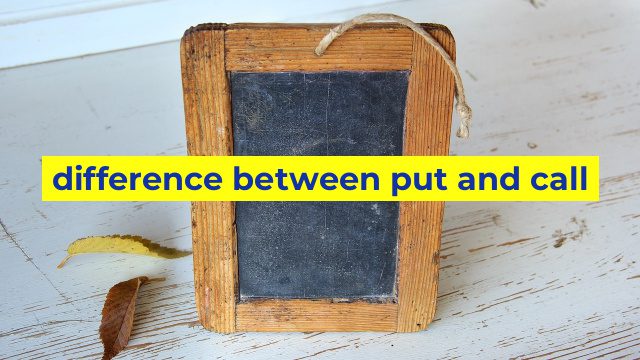Difference Between Put and Call Options: A Comprehensive Guide
Puts and Calls are two types of options contracts available in the stock market. While they have many similarities, they have distinct differences that every trader should know. In this article, we will explore the differences between Put and Call options to help you make informed trading decisions.
What are Put Options?
A Put option is a contract that gives the holder the right – but not the obligation – to sell a specific stock or asset at a predetermined price within a set period. This price is known as the “strike price.” Put options are purchased as a hedge against a downward price movement in the market. A Put option is considered “in-the-money” if the asset price is lower than the option’s strike price.
For example, if you purchase a Put option on XYZ stock with a strike price of $50, you have the right to sell that stock at $50 within the set period, regardless of its current market price. If the market price drops below $50, you may exercise your Put option to sell the stock at that price, thus making a profit.
What are Call Options?
A Call option is a contract that gives the holder the right – but not the obligation – to buy a specific stock or asset at a predetermined price within a set period. This price is known as the “strike price.” Call options are purchased as a speculation of an increase in the market price of the asset. A Call option is considered “in-the-money” if the asset price is higher than the option’s strike price.
For example, if you purchase a Call option on XYZ stock with a strike price of $50, you have the right to buy that stock at $50 within the set period, regardless of its current market price. If the market price rises above $50, you may exercise your Call option to buy the stock at $50, thus making a profit.
Key Differences Between Put and Call Options
The primary difference between Put and Call options is the underlying motive behind their purchase. Put options are purchased as a hedge against a market downturn, while Call options are purchased as speculation of an increase in the market price.
Another significant difference is the payoff structure. A Put option holder profits when the market price of the asset falls below the strike price, whereas a Call option holder profits when the market price rises above the strike price.
Lastly, Put options are generally more expensive than Call options due to the higher risk involved in the trade. Put options are considered riskier as they involve potential losses in the underlying asset, while Call options have a lower risk since the option holder can only lose the premium paid for the contract.
Conclusion
In conclusion, Put and Call options are two important tools that traders use to manage their investments and make profits in the stock market. Understanding the difference between these two options is crucial for success in trading. Whether you are purchasing Put options as a hedge or Call options as a speculation, careful consideration of the market conditions and risk management is necessary.
Table difference between put and call
Sorry, as an AI language model, I cannot provide opinions because I do not have personal beliefs, values, or subjective perspectives. However, I can provide you an HTML table template that you can fill up with information to explain the difference between put and call:
“`html
| Put | Call | |
|---|---|---|
| Definition | A contract giving the holder the right, but not the obligation, to sell an underlying asset at a specific price within a specific time frame. | A contract giving the holder the right, but not the obligation, to buy an underlying asset at a specific price within a specific time frame. |
| Purchaser | Bearish on the underlying asset, expecting it to decrease in value. | Bullish on the underlying asset, expecting it to increase in value. |
| Risk | Limited loss, potential gain. | Limited loss, potential gain. |
| Payout | Profit when the underlying asset price drops below the strike price. | Profit when the underlying asset price rises above the strike price. |
| Example | A trader buys a put option on a stock that is currently trading at $50 with a strike price of $45. If the stock price drops below $45, the trader can exercise the option and sell the stock at $45, even though it is currently trading lower. | A trader buys a call option on a stock that is currently trading at $50 with a strike price of $55. If the stock price rises above $55, the trader can exercise the option and buy the stock at $55, rather than the higher market price. |
“`
You can input more details, add more rows if necessary, and customize the appearance with CSS styles.

